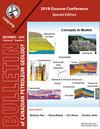艾伯塔省克里斯蒂娜湖热采项目的盖层完整性测定
Q3 Earth and Planetary Sciences
引用次数: 15
摘要
Cenovus-ConocoPhillips Christina Lake油砂项目采用蒸汽辅助重力排水(SAGD)技术,在300 ~ 400米深度的McMurray组开采沥青。克里斯蒂娜湖油田的麦克默里组由河流到河口的砂和泥组成,上面覆盖着清水组瓦比斯考成员的海洋页岩和砂。SAGD过程包括在压力下注入蒸汽以调动沥青,然后将沥青泵送到地面。预计增加的储层压力将被盖层所控制。如果盖层无法控制这些压力,蒸汽和石油可能会泄漏到较浅的单元,甚至可能会泄漏到地面。这不是一个理想的结果。我们描述了一个过程来表征覆盖层和评价盖层强度。最小原位主应力为油藏工作压力的5倍,启动压力的2.5倍。油藏围压为4.5 MPa时的抗压强度为操作压力的6倍,启动压力的3倍。wabisow成员显示包含横向连续和不渗透的半固化泥浆。孔隙度和渗透率低,毛管进入压力高。介绍了一种地下和地表监测程序。本文章由计算机程序翻译,如有差异,请以英文原文为准。
Caprock integrity determination at the Christina Lake Thermal Recovery Project, Alberta
Abstract The Cenovus-ConocoPhillips Christina Lake oilsands project uses Steam-Assisted Gravity Drainage (SAGD) to recover bitumen from the Lower Cretaceous McMurray Formation at depths between 300 and 400 m. The McMurray Formation at the Christina Lake Field consists of fluvial to estuarine sands and muds capped by marine shales and sands of the Wabiskaw member of the Clearwater Formation. The SAGD process involves injecting steam under pressure to mobilize the bitumen, which is then pumped to the surface. The increased reservoir pressure is expected to be contained by the caprock. In the event of a failure of the caprock to contain these pressures the steam and oil may escape to shallower units and possibly the surface. This is not a desired outcome. We describe a process to characterize overburden and evaluate caprock strength. The minimum in situ principal stress is shown to be five times reservoir operating pressure and 2.5 times startup pressure. Compressive strength at the reservoir confining pressure of 4.5 MPa is six times operating pressure and three times startup pressure. The Wabiskaw member is shown to contain laterally continuous and impermeable semiconsolidated muds. Porosities and permeabilities are low and capillary entry pressure is high. A program of subsurface and surface monitoring is described.
求助全文
通过发布文献求助,成功后即可免费获取论文全文。
去求助
来源期刊

Bullentin of Canadian Petroleum Geology
Earth and Planetary Sciences-Geochemistry and Petrology
CiteScore
2.50
自引率
0.00%
发文量
0
期刊介绍:
The Bulletin of Canadian Petroleum Geology is a peer-reviewed scientific journal published four times a year. Founded in 1953, the BCPG aims to be the journal of record for papers dealing with all aspects of petroleum geology, broadly conceived, with a particularly (though not exclusively) Canadian focus. International submissions are encouraged, especially where a connection can be made to Canadian examples.
 求助内容:
求助内容: 应助结果提醒方式:
应助结果提醒方式:


